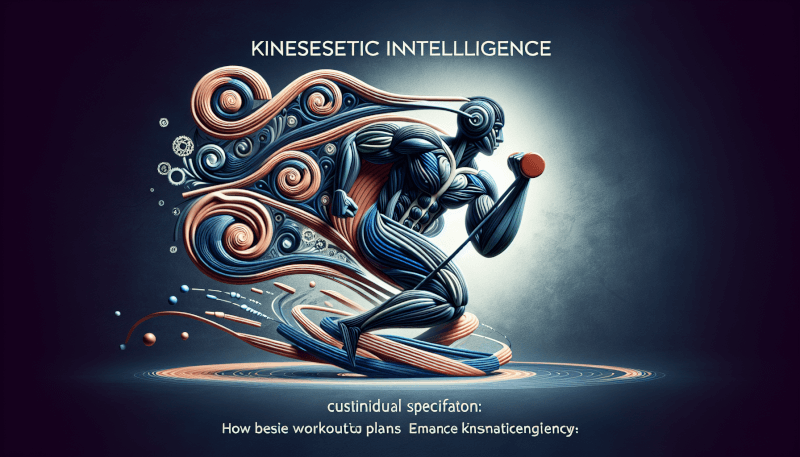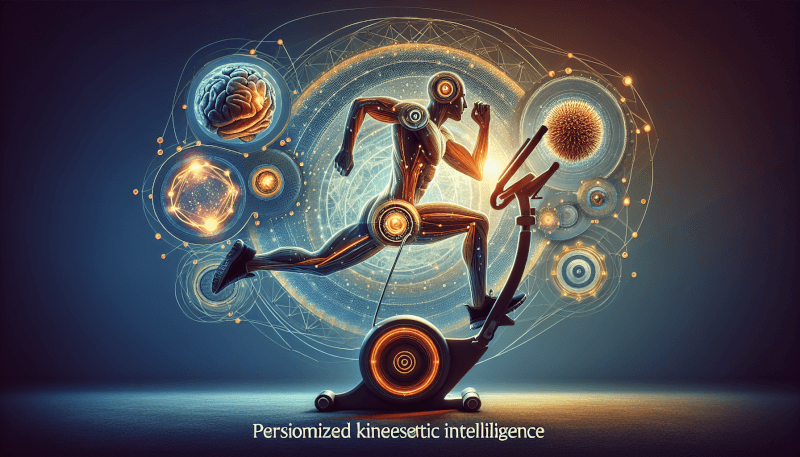Are you ready to take your physical intelligence to the next level? Look no further than custom workout plans designed specifically to enhance your kinesthetic intelligence. Kinesthetic intelligence refers to our ability to understand, control, and coordinate our body movements. By following personalized workout routines that target your unique abilities and areas of improvement, you can unlock a whole new level of physical awareness and mastery. Whether you’re an athlete looking to fine-tune your skills or simply someone interested in fostering a deeper mind-body connection, these tailor-made workout plans are bound to transform your physical abilities and boost your overall performance. Get ready to unleash your true potential!
Understanding Kinesthetic Intelligence
Definition of Kinesthetic Intelligence
Kinesthetic intelligence refers to the ability to learn and understand through physical movement and hands-on experience. It is one of the multiple intelligences identified in Howard Gardner’s theory of multiple intelligences. Individuals with high kinesthetic intelligence have a heightened awareness of their bodies and an exceptional ability to control their movements.
Importance of Kinesthetic Intelligence
Kinesthetic intelligence plays a crucial role in various aspects of life. It is especially valuable in fields that require physical skills, such as sports, dance, and performing arts. People with high kinesthetic intelligence often excel in hands-on professions like carpentry, surgery, and physical therapy. Additionally, kinesthetic intelligence is closely linked to overall cognitive development, including problem-solving skills and attention span.
Identifying Kinesthetic Learners
Identifying kinesthetic learners is essential for developing tailored workout plans. Kinesthetic learners typically exhibit certain characteristics, such as a preference for physical activities over traditional lectures or reading assignments. They often enjoy using their hands and engaging in activities that involve movement, like sports or arts and crafts. Kinesthetic learners also tend to have excellent hand-eye coordination and may struggle with tasks that require sitting still for extended periods.
Benefits of Enhancing Kinesthetic Intelligence
Improved Motor Skills
One of the primary benefits of enhancing kinesthetic intelligence is the improvement in motor skills. When you focus on activities that challenge your body and require precise movements, such as balance exercises or bodyweight workouts, you train your muscles, joints, and nervous system to work in sync. This enhanced motor control can translate into improved performance in various physical activities, better coordination, and increased agility.
Enhanced Body Awareness
Developing kinesthetic intelligence through targeted workout plans can greatly enhance your body awareness. You become more attuned to the movements, positioning, and sensations in your body, which can be especially beneficial for activities that demand precise body control. Improved body awareness can also help prevent injuries, as you become more conscious of how your body moves and learn to detect potential imbalances or weaknesses.
Better Problem-Solving Skills
Kinesthetic intelligence is closely tied to problem-solving skills. Through physical activities and movement, you develop the ability to analyze situations, make decisions on the spot, and adapt quickly. This heightened problem-solving ability can extend beyond the realm of physical activities and positively impact other areas of your life. The critical thinking and decision-making skills honed through physical challenges can be transferred to academic or professional settings, enabling you to approach problems with a creative and flexible mindset.

Designing a Custom Workout Plan
Assessing Individual Abilities
Designing a custom workout plan starts with a thorough assessment of your individual abilities. Take the time to understand your current fitness level, any limitations or injuries you may have, and your specific goals. By assessing factors such as strength, flexibility, and endurance, you can tailor your workout plan to suit your unique needs and abilities.
Setting Goals
Setting clear and achievable goals is crucial for designing an effective workout plan. Whether your goal is to improve performance in a specific sport, increase overall strength and flexibility, or simply lead a healthier lifestyle, having a target to work towards will help you stay motivated and focused. It’s essential to set both short-term and long-term goals, ensuring that you have milestones along the way to track your progress.
Choosing Suitable Activities
When designing a custom workout plan, it is important to choose activities that align with your interests and preferences as a kinesthetic learner. Consider incorporating activities that involve bodyweight exercises, dynamic movements, or sports that you enjoy. By selecting activities that excite and motivate you, you are more likely to stay consistent and engaged with your workout plan.
Incorporating Multiple Sensory Modalities
Adding Visual Elements
To enhance kinesthetic intelligence, it is beneficial to incorporate visual elements into your workout routine. Visual aids, such as demonstrations or instructional videos, can provide a clear representation of how exercises should be performed. This visual guidance can help kinesthetic learners better understand and execute movements correctly.
Including Auditory Stimuli
In addition to visual elements, including auditory stimuli can further enhance kinesthetic intelligence. Utilize cues or instructions provided through audio, such as verbal guidance or counting during exercises. This auditory input reinforces the mind-body connection and can improve focus, coordination, and timing.
Tactile and Proprioceptive Integration
Integrating tactile and proprioceptive stimuli into your workouts can significantly boost kinesthetic intelligence. Tactile feedback, such as the feeling of resistance from equipment or the texture of different surfaces, helps develop a heightened sense of body awareness. Additionally, proprioceptive exercises that challenge balance and body positioning, such as yoga or Pilates, promote a greater understanding and control of body movements.

Strengthening Key Kinesthetic Skills
Balance and Coordination Exercises
Balance and coordination exercises are valuable for strengthening key kinesthetic skills. Movements that challenge your balance, such as standing on one leg or performing exercises on an unstable surface, help improve your overall stability and body control. Coordinative exercises, such as juggling or agility drills, require precise and synchronized movements, further enhancing your kinesthetic intelligence.
Fine and Gross Motor Skill Development
Fine motor skills, involving small muscle groups, and gross motor skills, involving larger muscle groups, both contribute to kinesthetic intelligence. Fine motor skill exercises, like finger dexterity drills or hand-eye coordination activities, hone your ability to control precise movements. Gross motor skill development through activities like weightlifting or running improves overall strength, power, and coordination.
Body and Spatial Awareness Training
Developing body and spatial awareness is essential for enhancing kinesthetic intelligence. Engage in activities like dance or martial arts that require a heightened sense of body positioning and movement in space. These activities improve your ability to recognize the orientation of your body, synchronize movement patterns, and perform intricate sequences with precision.
Targeting Core Muscles and Posture
Core Strengthening Exercises
Targeting the core muscles is crucial for overall body control, balance, and posture. Incorporate exercises that engage the abdominal muscles, lower back, and pelvic region to build a strong core. Planks, bridges, and rotational exercises are effective in strengthening the core and improving stability.
Improving Posture and Alignment
Improving posture and alignment is vital for maximizing kinesthetic intelligence. Poor posture can negatively affect body mechanics and movement efficiency. Focus on exercises that promote good posture, such as yoga or postural correction exercises, to realign the spine and strengthen the muscles supporting proper alignment.
Functional Training for Overall Strength
Functional training exercises, which mimic real-life movements and activities, are ideal for developing overall strength and kinesthetic intelligence. By performing exercises that simulate everyday actions, such as squatting, lunging, or carrying weighted objects, you build functional strength that directly translates into improved physical performance and movement efficiency.

Progressive Overload and Skill Progression
Gradual Increase in Intensity and Difficulty
To continually enhance kinesthetic intelligence, it is important to employ progressive overload and gradually increase the intensity and difficulty of your workouts. This progressive increase challenges the body and prompts adaptation, resulting in improved physical abilities. Gradually increase factors like weight, repetitions, or complexity of movements to ensure ongoing growth and skill progression.
Periodization Techniques
Utilizing periodization techniques can be beneficial for skill progression and avoiding plateaus in kinesthetic intelligence. Periodization involves dividing your training into distinct phases, focusing on different aspects of fitness, and manipulating variables like volume and intensity. By strategically altering your workout plan over time, you can continue to improve and prevent stagnation.
Advancing Skills and Complex Movements
As you develop your kinesthetic intelligence, it is essential to challenge yourself with advanced skills and complex movements. This progression keeps your workouts engaging, stimulating your mind-body connection and pushing your physical limits. Continuously seek to master new movements or incorporate more intricate exercises that require coordination, balance, and control.
Creating Variation and Engaging the Mind
Incorporating Challenges and Games
To keep your workouts enjoyable and engaging, incorporate challenges and games into your routine. By setting up obstacle courses, puzzles, or interactive workouts, you stimulate your mind and heighten your kinesthetic intelligence. These activities provide a dynamic and exciting training environment, enhancing your ability to problem-solve and think creatively in a physical context.
Utilizing Brain-Body Connection
Expanding kinesthetic intelligence involves maximizing the brain-body connection. Focus on exercises that require mental engagement and conscious muscle activation. By intentionally thinking about specific muscle groups during exercises or incorporating mind-body practices like tai chi or yoga, you deepen the connection between your thoughts and movements, sharpening your kinesthetic intelligence.
Integrating Multifunctional Movements
Integrating multifunctional movements into your workouts challenges your kinesthetic intelligence and improves overall physical performance. These movements involve combining multiple muscle groups and movement patterns in a coordinated manner. Functional training exercises such as kettlebell swings, medicine ball throws, or loaded carries require the integration of various muscle groups, challenging your body’s ability to move efficiently and effectively.

Tracking Progress and Making Adjustments
Regular Performance Assessment
Regularly assessing your performance provides valuable feedback on your progress and helps identify areas for improvement. Track metrics such as strength gains, flexibility improvements, or increased endurance. Consider keeping a workout log or using technology tools to monitor your performance accurately.
Monitoring Strengths and Weaknesses
Identifying your strengths and weaknesses is crucial for continually enhancing kinesthetic intelligence. Pay attention to areas where you excel and continually challenge yourself in those areas. Simultaneously, address weaknesses by focusing on exercises or activities that target those specific areas to achieve a more balanced and well-rounded kinesthetic intelligence.
Modifying Workout Plans Accordingly
As you track your progress and evaluate strengths and weaknesses, be prepared to modify your workout plan to optimize your kinesthetic intelligence. Tailor your routine to emphasize areas that need improvement while maintaining a balance of exercises that challenge your existing strengths. Adjusting your workout plan ensures ongoing growth and development.
Conclusion
Embracing and enhancing kinesthetic intelligence through custom workout plans can lead to remarkable personal growth. Developing better motor skills, enhancing body awareness, and improving problem-solving abilities are just a few of the benefits that come with focusing on kinesthetic intelligence. By designing a custom workout plan that incorporates multiple sensory modalities, strengthens key kinesthetic skills, targets core muscles and posture, employs progressive overload, creates variation, and tracks progress, you can maximize your kinesthetic intelligence and unlock your full physical potential. So, get ready to embark on a journey of self-discovery, self-improvement, and an overall healthier lifestyle through custom workout plans designed to enhance kinesthetic intelligence.



